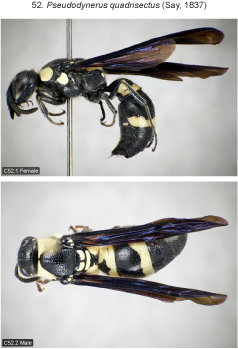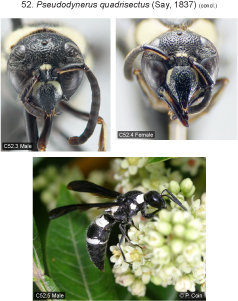
| Home | Table of contents | Keys | Species list | Glossary | Image data | PDF | Cite this article | Feedback | Updates |
Identification Atlas of the Vespidae (Hymenoptera, Aculeata) of the northeastern Nearctic region
CJAI 05, February 19, 2008
doi: 10.3752/cjai.2008.05
Matthias Buck, Stephen A. Marshall, and David K.B. Cheung
Department of Environmental Biology, University of Guelph, Guelph, Ontario, Canada N1G 2W1
52. Pseudodynerus quadrisectus (Say, 1837)
Figs B2.21, 40; C52.1–5.

|

|
Species recognition. The habitus of this species is reminiscent of Euodynerus but the body shape is more elongate. Pseudodynerus quadrisectus can be distinguished from other ivory-marked Eumeninae with strongly infuscated wings by the following characters: Male clypeus usually predominantly black. Propodeum with a distinct shelf-like horizontal area behind metanotum, posteriorly delimited by a sharp, serrate carina that is narrowly interrupted medially. Propodeal carina short, only defined dorsally, not developed laterally. Tergum 1 completely smooth and very shining between well-spaced punctures, conspicuously long-haired (hair length up to 3x mid ocellar diameter or more) but hairs sparse.
Variation (in part after Bequaert 1941). Fore wing length 10.5–13 mm (♂♂), 12–16 mm (♀♀). Extent of ivory markings quite variable: Inner orbit of female sometimes with ivory mark below ocular sinus. Clypeus with paired dorsal spots, sometimes confluent and forming a crescent-shaped mark, rarely completely black; in male also often with paired ventral spots (sometimes only with ventral spots), rarely completely ivory except apical and ventrolateral margins. Mandible with ivory basal mark in female, small or absent in male. Pronotum with broad anterior ivory band, sometimes almost completely ivory except posterolateral margin and ventral portion. Scutum rarely with a pair of tiny anterolateral ivory spots adjacent to pronotum. Scutellum sometimes with a pair of ivory spots, rarely confluent. Dorsal surface of propodeum with a pair of ivory spots, sometimes broken up into two or three spots, sometimes almost completely ivory extending down below level of propodeal angle. Tegula and hind coxa occasionally marked with ivory. Mesopleuron besides the usual large dorsal spot sometimes with additional small ivory spots behind scrobal furrow and on lower mesopleuron. Tergum 1 with apical fascia sometimes covering most of dorsal surface except median black spot. In male tergum 2 rarely with small ivory lateral spots near base and tergum 3 rarely with small lateral spots near apical margin; exceptionally tergum 3 with complete and tergum 4 with interrupted apical fascia. Mid and hind coxa usually with ivory spot. Fore and mid tibia usually with ivory stripe or spot, better developed on former, sometimes absent.
Distribution. Not recorded from Canada. Eastern U.S.: northern NJ (Bergen Co.), eastern PA (Pittsburgh area), northern OH (Ashland Co.) and central IL south to FL and west to eastern parts of KS, OK and TX (Bequaert 1941). The ssp. aztecus (de Saussure, 1857) occurs in Mexico and Costa Rica (West-Eberhard et al. 1995, Rodríguez-Palafox 1996).
Biology. Nests in cavities in wood and makes mud partitions between brood cells. Prey are caterpillars (Krombein 1979).
| Home | Table of contents | Keys | Species list | Glossary | Image data | PDF | Cite this article | Feedback | Updates |
